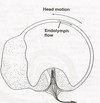Vestibular System Flashcards
(43 cards)
What are the three main elements in signalling of the vestibular system?
Input - visual, pressure(proprioreceptors), vestibular organ (in the ear)
Central processing - mostly brainstem
Output - ocular reflex, spinal reflexes for postural control.

What is the name of the balance organ in the ear? Where is it found?
labyrinth
Contained inside the temporal bone

Describe the structure of the vestibular system in the ear?
Bony labyrinth covers the mebranous labyrinth.
5 organs:
- Otolith organs - utricle and saccule
- 3 semicircular canals all attached to utricle but different - horizontal, superior, inferior.
Fluid inside the membranous membrane = endolymph
Fluid outside membranous membrane = perilymph

What are the static and kinetic parts of the labyrinth?
Static - otolith organs
Kinetic - semicircular canals
Which two semicircular canals come together?
Superior(/anterior) and inferior(/posterior) - these have only one entrance into the utricle.
Horizontal canal has its won entrance.

Why are the ends of the semicircular canals wider?
They contain the ampulla, cupula and kinocilia.
What are the two branches of the vestibulocochlear nerve and where do they go?
NB: CNVIII
- Vestibular part goes to the vestibular organ
- Cochlear part goes to the cochlea
What are the two types of cells involved in transduction in the vestibular organs?
Hair cells: type I and type II
Which hair cells in the vestibular organ are more numerous? Describe their afferents and efferents.
Type I
- are round and are more numerous.
- have direct afferents around the cells and indirect efferents.
- are the main cells responsible for the afferent signals of the vestibular system.
Type II
- are long
- have direct afferents and efferents but there are fewer of them.

What do the otolith organs consist of?
- Utricle
- Saccule
- Maculae (shown as the striped regions on picture below)
- Hair cells
- Gelatinous matrix
- Otoliths = carbonate crystals

What is the striola?
STRIOLA, a curved dividing ridge that runs through the middle of the MACULA
- in the UTRICLE, the kinocilia are oriented TOWARD the striola,
- in the SACCULE they are oriented AWAY from it

What do the semicircular canals consist of?
- Ampulla - dilated sac at the end of the semicircular canals
- Crista ampullaris - contains the hair cells
- Cupula - gelatinous projections which contain the crista which contain the hair cells
- Kinociia - point in same direction on each side of the head
Semicircular canals are filled with endolymph.

Describe the organisation of the macula.
Some type I and type II cells present. Hair bundles sit above and gel sits on top of this and the crystals sit on top of the gelatinous matrix.

How are the semicircular canals layed out in relation to one another?
At 90 degrees to each other -

anterior canals are located at ~90o to each other; posterior canals are also located at ~90o to each other
Describe the blood supply to the inner ear.
Via AICA - anterior inferior cerebellar artery (which also goes to the cerebellum so any problems e.g. stroke affecting it will also affect the inner ear)
This is a branch of the basilar artery.

Name the two branches of the vestibular nerve. What do they supply? Where do they end?
Superior and inferior vestibular nerves
- Superior sends sensory information from the UTRICLE and anterior and horizontal canals.
- Inferior sends senory information from the SACCULE and posterior canals.
These end in the vestibular nuclei in the brainstem.
What is the name of the ganglia of superior and inferior vestibular nerves?
Scarpi’s ganglia
Name the different vestibular nuclei. Describe their organisation.
- Superior
- Lateral
- Medial
- Inferior
E.g. static labyrinth (otoliths) are connected mainly to the lateral and inferior nuclei.
E.g. kinetic labyrinth (semicircular canals) mainly send information to the superior and medial nuclei.

What are the 5 areas tha vestibular nuclei project to?
Vestibular pathways can project to:
- Spinal cord – to be connected to the muscles to maintain posture/prevent falling
- Nuclei of the extraocular muscles – moving eyes when walking
- Cerebellum – Movement coordination, posture regulation, VOR(vestibulo-ocular reflex) modulation
- Centers for cardiovascular + respiratory control
- Thalamus

Why do the bestibular nuclei project to the cerebellum?
- Movement coordination
- Posture regulation
- VOR(vestibulo-ocular reflex) modulation

Decribe the pathway of vestibular nuclei to the thalamus and cortex. What sensation do these projections account for?
Vestibular nuclei –> thalamus
–>thalamic nuclei –> the head region of the primary somatosensory cortex + to the superior parietal cortex(spacial orientation)
These cortical projections may account for feeling of dizziness during certain kinds of vestibular stimulation.

What is the purpose of the vestibular system?
To detect and inform brain about head movements.
To keep images fixed in the retina during head movements.
To maintain postural control.
Describe the firing of the nerve fibres of the vestibular system at rest.
Nerve fibres of the vestibular system are constantly firing – even when standing still.
- Resting discharge – nerve fibres always sending signals at a certain rate
- An increase in rate occurs when nerve cells are depolarised
- Decrease in rate when nerve cells are hyperpolarised.

What are the three types of responses of nerve fibres in the vestibular system? What is the mechanism?
So there are 3 types of responses:
- resting,
- excitation(hair bundles go in the direction of the kinocilium),
- inhibition(hair fibres go against the direction of the kinocilium).
Process:
- Kinocilia deflect, potassium and calcium enters. Neurotransmitter is released into the synapse and triggers a signal in the nerves.







